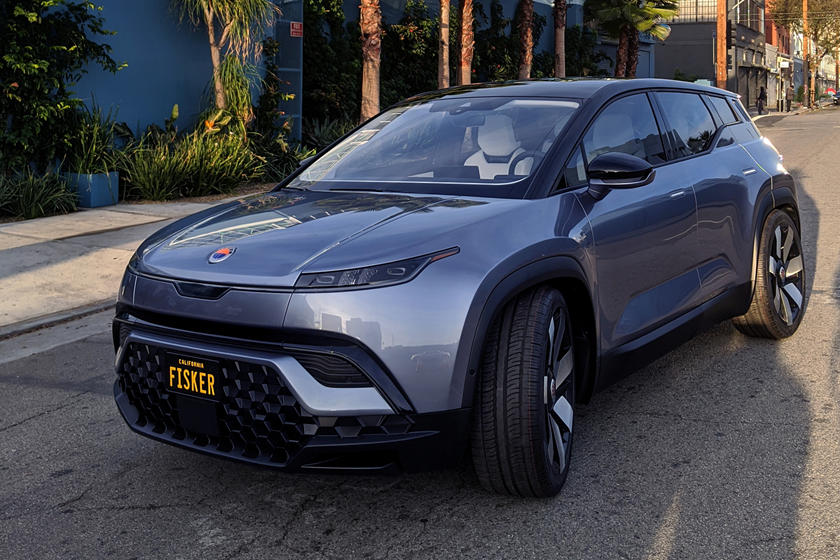by Gerhard Horn
The Fisker Ocean comes with a boatload of baggage. Fisker Automotive first started producing cars in 2011, most notably the Fisker Karma. The company went bust just a year later, sold, and renamed Karma.
The founder of the company, Henrik Fisker, retained the rights to his namesake and is once again taking on the automotive world.
This time around, Fisker seems to be better equipped. To start with, it's launching an electric SUV as opposed to a large sedan. The pricing is also more palatable, ranging from $37,499 to $68,999, while power will range from 275 to 540 horsepower.
The Ocean also comes with several shock and awe features you won't find anywhere else in the automotive world, which is exactly what a startup needs.
See trim levels and configurations:
If you look at the roof, you might notice a few odd Tron-like shapes. It's the SolarSky roof, available on top-end models. In ideal conditions, the charge gained from this solar panel can supply an additional 2,000 miles of range per year.
Fisker says he didn't want just another aerodynamic hatchback, which is why the Ocean has a wide stance and ultra-slim lighting. There is one 20-inch wheel option and three 22-inch designs to choose from.
Another exciting feature is California Mode. You push a button, and the Ocean lowers all its windows and retracts its sliding roof. Fisker says this provides an open-air convertible-like experience. However, we don't see the difference between this and any other car with a sliding panoramic roof and electric windows.
The Ocean does have a striking side profile. The floating roof slopes nicely to the rear, which works well with the rugged wheel designs. Another highlight is the extended wheel arches at the front and back. You don't notice them at first because they're neatly incorporated into the design, but they give the Ocean an extremely sporty stance.
A few manufacturers have started moving away from leather to be more environmentally friendly. Fisker takes it a step further by making the entire interior vegan. Every surface is covered in recycled materials, including reclaimed fishing nets, renewed rubber, and even old t-shirts.
The piece de resistance is the 17.1-inch central, high-resolution display. It has two modes. In control mode, it operates like a standard infotainment system. Using the screen, you control all of the car's features, including climate control, driving modes, navigation, and music. When the vehicle is parked, you can access Hollywood mode. The screen then rotates into landscape mode, which Fisker says creates an immersive viewing environment for front and rear passengers. Though it hasn't been confirmed, the latter statement leads us to believe that you can likely connect to streaming platforms like Netflix.
Over-the-air updates will be standard on all models, while Fisker's Hypersound is an available option. It's a 16-speaker, 500-watt system with a massive subwoofer.
There's also a Limo Mode that allows rear passengers to control the audio volume and the climate control system.
The base model will use a single motor and front-wheel drive. With one electric motor, the Ocean has 275 hp on tap and can sprint to 60 mph in 6.9 seconds. There's also a permanent AWD model with a dual electric motor setup, providing 540 hp. With that much power, it gets to 60 mph in 3.6 seconds. There's also a third option, which is an AWD where the driver can disengage the rear electric motor for an increased range. In other words, the best of both worlds.
Fisker will offer two battery packs. The Touring Range battery comes with an EPA-estimated driving range of 250 miles, while the Hyper Range battery takes it up to 350 miles.
As standard, the base Sport model will have two driving modes - Earth and Fun. One provides maximum range, while the other makes the car more, erm, fun.
The Ultra, Extreme, and Ocean One trims get the above modes, plus Hyper and Off-Road. Hyper is meant to chase Teslas, while the Off-Road mode sets the car up for that purpose. In addition to the above, the three top trims will also have Smart Traction torque vectoring.
The entry-level Sport with FWD is priced at $37,499, making it one of the cheapest EVs on sale. The Ultra retails for $49,999, while the Extreme costs $68,999. The first 5,000 models will be called the Ocean One, retailing for the same as the Extreme.
The Fisker undercuts all of its main rivals, especially from Germany. It faces an uphill battle with Tesla, however. Prices for the Model Y start at around $40k for the Standard Range. The Audi Q4 e-tron plays around in the $40k to $50k segment. It's arguably more striking and will almost certainly have a better quality interior. The base models only have 201 hp, but it has the same 250-mile claimed range as the Fisker.
The Mercedes EQC competes directly with the top-end models. While the styling is odd, one can't help but appreciate the interior styling. It also has a dual motor setup, but you only get 408 hp and a claimed range of 276-292 miles.
While the Fisker Ocean appears to be the winner on paper, it's going to be tough to lure potential customers away from brands that have existed for decades. Or a little over a decade in the case of Tesla.
The most popular competitors of 2022 Fisker Ocean:


